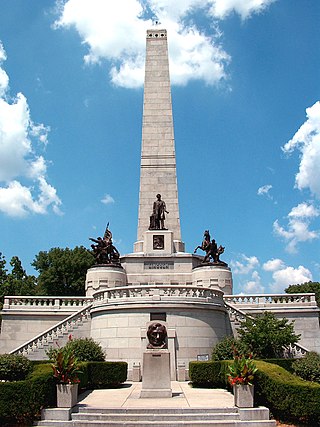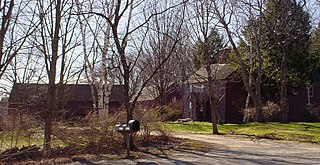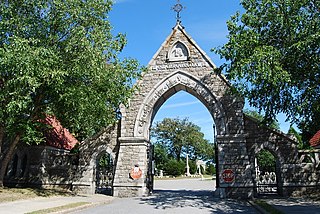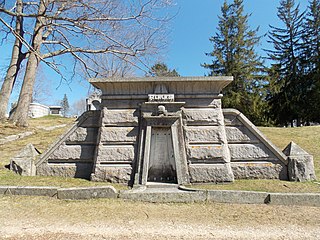
The Lincoln Tomb is the final resting place of Abraham Lincoln, the 16th President of the United States; his wife Mary Todd Lincoln; and three of their four sons: Edward, William, and Thomas. It is located in Oak Ridge Cemetery in Springfield, Illinois. It is constructed of granite and has a large, single-story rectangular base surmounted by an obelisk, with a semicircular receiving room entranceway on one end and a semicircular crypt or burial-room opposite.

Deering Oaks is a 55-acre (22 ha) public park in Portland, Maine, which has a baseball diamond, tennis courts, a playground, and a pond. It is located west of downtown Portland and is bordered by Deering Avenue on the west, Forest Avenue on the east, Park Avenue to the south and Interstate 295 to the north. State Street bisects the park. Access is from State Street, Deering Avenue, or Park Avenue. The Portland Farmers Market is located on the Park Avenue side of the park. The park is listed on the National Register of Historic Places.

Boon Island Light is located on the 300-by-700-foot Boon Island off the southern coast of Maine, United States, near Cape Neddick. Boon Island Light has the distinction of being the tallest lighthouse in both Maine and New England at 133 feet (41 m). The lighthouse has a focal plane at 137 feet (42 m) above mean high water. The light's beacon flashes white every 5 seconds.

The Redington Museum or Redington House is a historic house and museum in Waterville, Maine that is listed on the National Register of Historic Places. The museum is the headquarters of the Waterville Historical Society. Built in 1814, it is one of the best-preserved houses of the period in the city. It has served since 1924 as the museum and headquarters of the Waterville Historical Society, and was listed on the National Register of Historic Places in 1978.

The John Sedgley Homestead is a historic homestead property at Scituate and Chases Pond Road in the York Corner area of York, Maine. Its oldest structure built in the late First Period, probably c. 1715, it is the oldest homestead in the State of Maine that is still in its original setting. Historically the homestead included a cape, farm home, carriage house, stables building, two outbuildings, and a large land holding, all of which is still existing today. The property was listed on the National Register of Historic Places in 1976.

Oak Grove Cemetery is a historic cemetery located at 765 Prospect Street in Fall River, Massachusetts. It was established in 1855 and greatly improved upon in the years that followed. It features Gothic Revival elements, including an elaborate entrance arch constructed of locally quarried Fall River granite. The cemetery originally contained 47 acres, but has since been expanded to over 120 acres. The cemetery is the city's most significant, built in the planned rural-garden style of Mount Auburn Cemetery in Cambridge, Massachusetts. It was designed and laid out by local architect Josiah Brown, who is also known for his designs of early mills including the Union, Border City, and others.

Glenwood Cemetery is a historic rural cemetery northeast of Parker Street and Great Road in Maynard, Massachusetts. It is one of the first municipal creations of the town after its incorporation in 1871, and is the resting place of many of its early and prominent residents, including Amory Maynard, founder of the Assabet Woolen Mill and namesake of the community. The cemetery was added to the National Register of Historic Places (NR#04000425) on May 12, 2004.

The Wing's Neck Light is a historic lighthouse in the Pocasset village of Bourne, Massachusetts. It is located on Wing's Neck Road at the end of Wing's Neck, a peninsula between Pocasset Harbor and the Hog Island Channel, which provides access to the Cape Cod Canal. The first lighthouse was built in the site in 1849; it was a stone keeper's house with a wood-frame tower above, and was destroyed by fire in 1878.
Leland Castle is a building in New Rochelle, New York. It was constructed during the years in 1855 - 1859 in the Gothic Revival style, and was the country residence of Simeon Leland, a wealthy New York City hotel proprietor. Leland began to assemble an estate as early as 1848, and in 1855, began the erection of this palatial 60-room mansion. The home was designed by New York City architect William Thomas Beers. A north and south wing were added to the castle in 1899 and 1902 respectively.

Eastern Cemetery is a historic cemetery at the intersection of Washington Avenue and Congress Street in the East Bayside neighborhood of Portland, Maine. Established in 1668, it is the city's oldest historic site, and has more than 4,000 marked graves. It was listed on the National Register of Historic Places in 1973.

Dana Meeting House is a historic meeting house on Dana Hill Road in New Hampton, New Hampshire.

Kent Burying Ground is a historic cemetery at the corner of Fayette Corner Road and Oak Hill Road in Fayette, Maine. Established in 1880 by Elias Kent, it is unusual for its layout of concentric rings around a central monument, only known in one other cemetery in the state, the Wing Family Cemetery in nearby Wayne. The cemetery was listed on the National Register of Historic Places in 2008.

The Eastern Promenade is a historic promenade, 68.2-acre (27.6 ha) public park and recreation area in Portland, Maine. Construction of the Promenade began in 1836 and continued periodically until 1934. The 1.5-mile (2.4 km) park was designed by the Olmsted Brothers design firm and experienced its greatest expansion from the 1880s to the 1910s. The Promenade rings around the Munjoy Hill neighborhood and occupies the farthest eastern portion of Portland's peninsula. The Promenade is home to many historical sites, including a mass grave and the mast of USS Portland.

The F.O.J. Smith Tomb is an historic tomb in Evergreen Cemetery in Portland, Maine. It is the tomb of Francis Ormand Jonathan Smith (1806–76), US Congressman 1833-39. It was probably built by Smith in 1860, at the time of his daughter Lizzie's death, and is one of Maine's most sophisticated expressions of Egyptian Revival architecture. It was added to the National Register of Historic Places in 1974.

The St Jude's Church is an active Anglican church in Randwick, a suburb of Sydney, New South Wales, Australia. It is part of a significant heritage group that includes the church, cemetery, rectory and original Randwick Borough Chambers, later converted to church use. The group is located on Avoca Street, Randwick, and has a federal heritage listing. It was added to the New South Wales State Heritage Register on 2 April 1999.

Smith Chapel is a historic memorial chapel at 45 Mill Pond Road in Durham, New Hampshire, United States. Built in 1900 in the family cemetery of the locally prominent Smith family, it is a prominent local example of Late Gothic Revival architecture. It is now part of a small municipal park. The chapel was listed on the National Register of Historic Places in February 2013, and the New Hampshire State Register of Historic Places in April 2013.
The Free Baptist Church of Great Pond is a historic church building at 1231 Great Pond Road in Great Pond, Maine, a tiny rural community in northern Hancock County. Built c. 1890-95, it is the only architecturally significant public or civic building constructed in the town, serving as a church until about 1938. It was listed on the National Register of Historic Places in 2012, and is undergoing restoration by a local nonprofit for use as a community center.

The Paine Neighborhood Historic District of Standish, Maine encompasses a small collection of rural properties that were all developed within a short period of time by members of the Paine family. Included are three late 18th-century houses and the family cemetery. The area provides a view of early settlement patterns in Maine's interior. The district was listed on the National Register of Historic Places in 1985.

The Androscoggin Yacht Club is a private recreational and social club at 22 Lake Street in Wayne, Maine, on the shore of Androscoggin Lake. Founded in 1909, the club provides access to a beach and docks, and has a clubhouse available for the use of its members. The clubhouse was listed on the National Register of Historic Places in 2012, for its architecture and for the role the club played in the development of the region as a summer tourist destination.

The Simeon Smith Mansion is a historic farm property on Smith Road in West Haven, Vermont. The property, more than 100 acres (40 ha) includes a farmhouse dating to the 1790s, which was the seat of Simeon Smith, a prominent local doctor, politician, and landowner. The property was listed on the National Register of Historic Places in 1991.




















